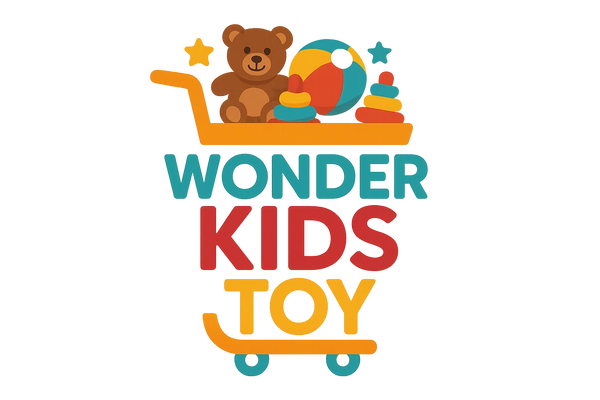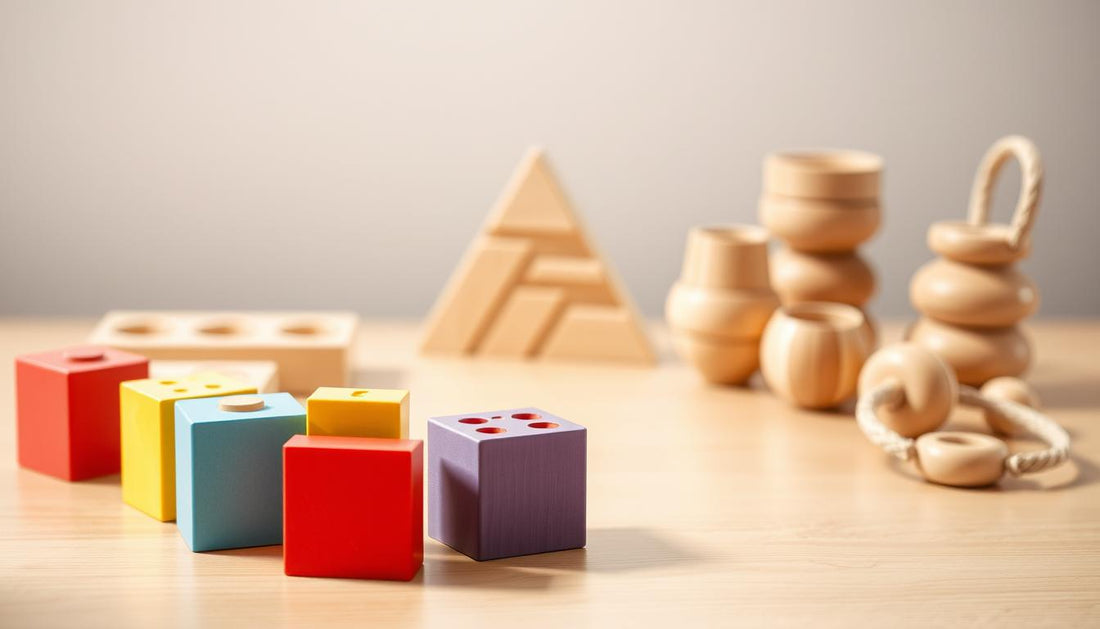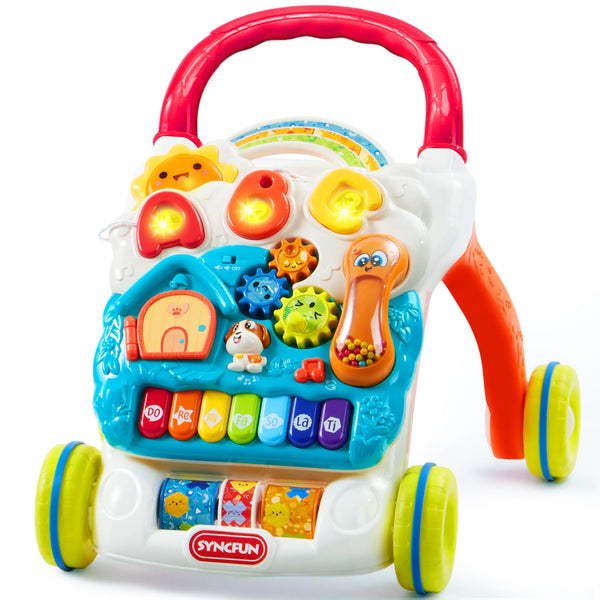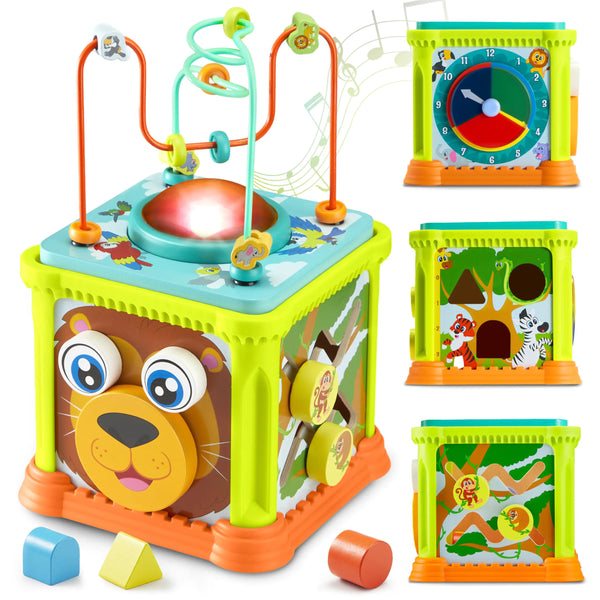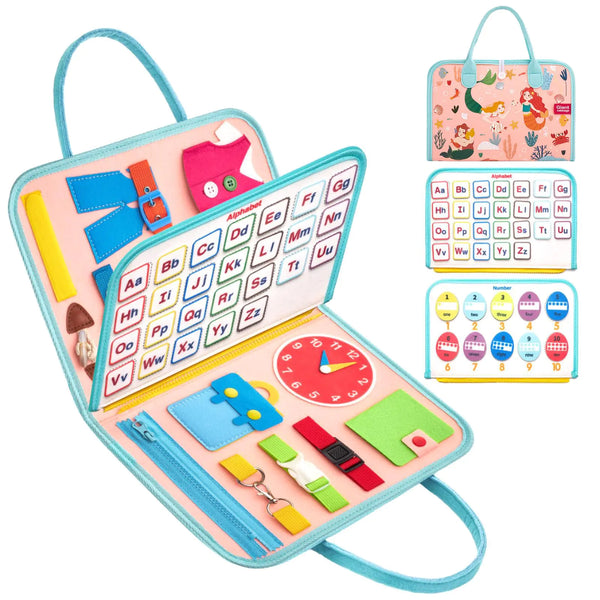Bringing new activities to toddlers can be tough for parents. But with the proper steps, it can spark their curiosity and creativity. Montessori methods work well.
Remembering the first time I introduced learning toys to my child was special. It made them more interested in their world. The trick is to make it fun and educational at the same time.
Key Takeaways
- Introduce new activities gradually to avoid overwhelming your child.
- Observe your child's interests and tailor the activities to match.
- Use a variety of materials to keep things interesting.
- Make sure the activities are challenging but not too hard.
- Be involved in the process to make learning more fun.
Understanding the Montessori Approach
Embracing the Montessori method means knowing its core principles. These principles help foster a child's independence and curiosity. The Montessori approach focuses on child-centered learning, hands-on activity, and collaborative play.
What are Montessori Toys?
Montessori toys are made to promote learning and development through self-directed activity. These educational toys let children explore, discover, and learn at their own pace. Unlike regular toys, Montessori materials are made from natural materials and last a long time.
Benefits of Montessori Toys
Montessori toys offer many benefits. They help improve fine motor skills, hand-eye coordination, and problem-solving abilities. These toys also foster independence, concentration, and self-confidence in children. By using Montessori materials, my toddler gains a deeper understanding of the world.
Key Principles of Montessori Learning
Montessori learning is based on several key principles. These include self-directed learning, hands-on activity, and collaborative play. The method creates a prepared environment that encourages children to explore and learn. Montessori materials are designed to support this environment, helping a child's natural desire to learn and grow.
By understanding and applying these principles, I can create a supportive and nurturing environment. This environment encourages my toddler's overall development.
Choosing the Right Montessori Toys

Choosing the right Montessori toys is key to my toddler's learning. Montessori focuses on independent learning and hands-on activities.
Age-Appropriate Selections
It's important to pick toys that match my toddler's age. Toys that are too hard or too easy can be a problem. For example, fine motor skills toys help with hand-eye coordination and dexterity.
Younger toddlers need safe, durable, and easy-to-grasp toys. As they get older, I introduce more complex toys. Wooden toys are great because they're eco-friendly and fun to touch.
Quality Over Quantity
In Montessori, quality toys are more important than having lots of them. I chose a few well-made, educational toys over many less meaningful ones. This helps keep things tidy and focused.
- Toys made from natural materials
- Toys that promote learning and development
- Toys that are durable and long-lasting
By choosing quality toys, I create a better learning space for my toddler.
Engaging with My Toddler’s Interests
Watching what my toddler loves helps me pick the right toys. When I see what they enjoy, I choose toys that match those interests. This makes learning more fun and effective.
If they love blocks, I get them more challenging building sets. This keeps them interested and helps them grow.
Introducing New Toys Gradually

Introducing new toys slowly is a key part of the Montessori method. It helps my toddler fully understand and connect with each toy. This way, they learn and grow in a meaningful way.
The Importance of Patience
Patience is key when introducing new open-ended toys and materials. Rushing can cause overwhelm and disinterest. A slow introduction allows my child to explore and appreciate each new toy.
For example, when introducing a new development toy, I show how to use it first. Then, I let my toddler play with it alone. This helps them become independent and solve problems.
Observing My Toddler's Reactions
Watching how my toddler reacts to new toys is essential. It helps me understand their interests and learning style. By observing, I can adjust how I introduce new toys.
If my toddler loves a particular texture or color, I use that to pick future toys. This personalized approach makes learning more fun and relevant for them.
Creating a Welcoming Environment
It's essential to create a welcoming space for play. This means setting up a dedicated area that's both organized and inviting.
Having a place for everything helps my toddler find and return toys. It teaches them about order and responsibility.
| Tips for Introducing New Toys | Benefits |
|---|---|
| Introduce one new toy at a time | Prevents overwhelm and allows for focused play |
| Demonstrate the toy's use | Encourages understanding and proper use |
| Allow independent exploration | Fosters independence and problem-solving skills |
| Rotate materials regularly | Keeps activities fresh and exciting |
By introducing toys slowly and creating a welcoming space, my toddler's learning has improved a lot. This method supports their growth and helps them love learning for life.
Setting Up a Montessori-Friendly Space

It's key to set up a Montessori-friendly space for my child's growth. A tidy environment lets my toddler explore and learn at their speed.
Organizing Toys for Easy Access
One main rule of a Montessori space is to make toys easy to reach. I use open shelves to showcase activities, making it easy for my toddler to see what's there. This helps them learn to make choices and be independent.
According to the second source, having fewer toys can boost focus, creativity, and engagement. So, I change out the toys often to keep things interesting and fresh.
Creating Defined Play Areas
It's also essential to have clear play zones in a Montessori space. This helps my child understand the purpose of each area and encourages meaningful play.
For example, I have a special area for sensory play with sensory toys that excite their senses. This makes playtime fun and helps them develop their senses.
| Play Area | Purpose | Examples of Toys/Materials |
|---|---|---|
| Sensory Play | Stimulate senses | Sensory balls, texture mats, sand |
| Reading Nook | Encourage reading | Picture books, comfortable seating |
| Art Corner | Foster creativity | Crayons, paints, coloring books |
Incorporating Nature Elements
Adding nature to the play space is a big part of a Montessori setup. I do this by adding plants, natural materials, and outdoor elements. This helps my child appreciate nature.
Using natural materials for Montessori Toys, such as wooden blocks and bamboo utensils, enhances the space's aesthetic appeal. It also teaches my child about being green.
By following these steps, I can make a space that supports my child's growth and encourages a love for learning.
Incorporating Play into Daily Routines

As a parent, I've learned that mixing play with daily routines is key. It makes learning fun for my toddler. This way, we blend educational toys and activities, sparking a love for learning.
Playtime as Learning Time
In the Montessori method, play is seen as a chance for growth. I choose learning toys that are both fun and teach something new. This lets my child explore and learn about their world.
- Using everyday objects to teach practical skills
- Choosing educational toys that help solve problems and think critically
- Doing activities that boost creativity and imagination
Balancing Structure and Freedom
It's crucial to find the right mix of structure and freedom in play. Too much of one can be bad. I aim for a balance that lets my child learn at their own pace.
This balance comes from:
- Setting a daily routine with playtime included
- Letting my child choose within the routine
- Being flexible and adjusting to their needs and interests
Transitions Between Activities
Transitions can be challenging for toddlers. But with a gentle approach, they can get easier. I use different strategies to help my child move between activities, like:
- Giving warnings before switching to a new activity
- Using visual cues to signal a change
- Encouraging my child to help with the transition
By adding play to daily routines and finding the right balance, I create a supportive environment. This helps my child grow and develop.
Involving My Toddler in Toy Selection

Letting my toddler pick their toys has made learning fun and boosted their confidence. It's great to see them grow more curious and confident.
Empowering Choices
Letting my toddler choose their own Montessori materials and fine motor skills toys helps them feel independent. It teaches them to make choices and understand the results of those choices.
When they choose their toys, they feel a stronger connection to them. This makes them more eager to learn and play with the toys.
Discussing New Adds to the Toy Collection
When we get new toys, we talk about them together. This helps my child learn new words and understand the toys' uses.
Talking about the Montessori materials helps my child see how they can help them grow. It's a great way to learn together.
Making Learning a Joint Effort
Choosing toys together has made learning a team effort. We know and have fun together, which strengthens our bond.
This way, I can see what my child likes and tailor learning to fit their needs. It makes learning more fun and effective for both of us.
Rotating Toys for Variety

Changing toys for my toddler keeps boredom away and makes playtime more fun. This method, called toy rotation, helps keep my child interested in playing.
The Benefits of Toy Rotation
Rotating toys has many perks, like reducing overwhelm and keeping play exciting. By introducing new or old toys, my toddler stays engaged with open-ended toys. These toys spark creativity and imagination.
One big plus of toy rotation is seeing what my toddler likes. This lets me pick toys that are just right, not too easy or hard.
How I Implement Toy Rotation
To start toy rotation, I sort my toddler's toys into groups. Then, I make a schedule that includes a mix of wooden toys and other items.
Watching how my toddler reacts to toys helps me plan the next rotation. If they love a toy, it goes into the next set.
Evaluating What Works and What Doesn’t
After starting toy rotation, I check if it's working. I watch how my toddler plays with the new toys. If they're not interested, the toy might be wrong.
By constantly checking and changing my toy rotation, my toddler stays excited and engaged. They get to try lots of different play experiences.
Encouraging Independent Play

Encouraging toddlers to play on their own is key to their growth. It lets them learn and explore at their speed. Giving my toddler space to play alone helps them feel independent and self-reliant.
Providing Space for Exploration
To support independent play, a safe and engaging space is needed. I set up a play area with development toys and sensory toys that match their interests. This helps them learn and grow.
I have a special corner in my home for sensory toys. There are playdough, sand, and water tables. These toys let my toddler explore different textures and materials.
Setting Up Challenges and Goals
Independent play is more than just toys. It's about challenges and goals that prompt them to think critically and solve problems. I use toys that need assembly or puzzles to solve.
- Toys that promote problem-solving skills
- Puzzles and brain teasers
- Building blocks and construction materials
Respecting My Toddler's Playtime
Respecting their playtime is vital for independent play. I don't interrupt them while they're playing. This lets them dive deep into their activities.
This teaches them the importance of focus and concentration. These skills are vital for their future success in school and life.
Observing and Adapting

The Montessori method focuses on observing and adapting to a child's interests and stage of development. As I introduce new Montessori toys and materials to my toddler, it's key to observe their reactions and adjust our approach.
Paying Attention to Interests
My toddler has clear preferences for Montessori Toys. Some days, they love puzzles, while others, they're into stacking blocks. By noticing these interests, I can make playtime more engaging and effective.
Adapting Based on Feedback
Feedback from my toddler during playtime is very valuable. It shows me what works and what doesn't, helping me adjust. For example, if they find a learning toy challenging, I might simplify it or introduce a new challenge gradually.
| Observation | Adaptation | Outcome |
|---|---|---|
| Toddler shows interest in sensory play | Introduce more sensory-based Montessori Toys | Enhanced engagement and exploration |
| Toddler struggles with a puzzle | Simplify the puzzle or introduce a similar, easier one | Builds confidence and problem-solving skills |
| Toddler enjoys stacking blocks | Provide more blocks and challenge them to build higher structures | Develops fine motor skills and patience |
Emphasizing Developmental Milestones
Watching my toddler's progress with Montessori Toys and learning toys helps me spot and support their developmental milestones. Whether it's improving fine motor skills with stacking or solving puzzles, I can offer specific support.
By keeping an eye on and adjusting, I'm not just improving my toddler's learning. I'm also creating a supportive environment that encourages growth and exploration.
Connecting Montessori Toys to Everyday Life

Adding Montessori toys to our daily routine has made learning fun for my toddler. It makes learning more relevant and enjoyable. This method also helps my child understand the world better.
Real-World Applications of Learning
Montessori materials show how learning applies to real life. For example, a toy kitchen lets my child practice cooking. This mirrors what I do in the kitchen. It makes learning hands-on and exciting.
Incorporating Household Tasks
Using toys to mimic household tasks is another great way to connect Montessori toys to daily life. My toddler can practice cleaning or doing laundry with toy tools. This teaches responsibility and improves fine motor skills.
Making Learning Relevant and Fun
I ensure that our activities with Montessori toys are relevant to our daily lives. Using a toy clock to learn about time or measuring cups during cooking makes learning fun. It helps my child understand concepts through practical use.
This way, my child sees the value in what they learn. It shows how it applies to their world. It's a powerful way to make education a part of everyday life.
Communicating the Value of Montessori Toys

Talking about Montessori toys is more than listing their benefits. It's about showing how they help my child grow. As I introduce new fine motor skills toys and Montessori materials, sharing our journey with others makes it richer. It helps them see the worth of these learning tools.
Sharing with Family and Friends
Sharing our experiences with family and friends is key. It makes my toddler proud of their growth. For example, when we get new wooden toys, they love to show and tell what they've learned.
"The more we share our journey with others, the more we realize the significant impact Montessori toys have on our children's development," a fellow Montessori parent once said. This quote hits home, showing how important community is in understanding the Montessori method.
Documenting Progress and Development
Keeping a record of my toddler's growth is very helpful. It shows how Montessori toys help them develop. For instance, I've seen significant improvements in problem-solving and critical thinking with certain Montessori materials.
- Tracking milestones in fine motor skills
- Observing improvements in cognitive development
- Noting advancements in social and emotional growth
Celebrating Milestones
Celebrating milestones is a significant way to demonstrate the value of Montessori toys. Whether it's mastering a new skill or finishing a challenging task, it's important to acknowledge these achievements. This not only boosts my child's confidence but also inspires others to try the Montessori method.
In short, sharing our experiences, documenting progress, and celebrating milestones are key. They help us understand and share the value of Montessori toys. This way, we build a community that values learning centered on the child.
Fostering Creativity and Imagination

When I introduce new Montessori toys to my toddler, I focus on creativity and imagination. This helps their creative thinking and overall growth.
Open-Ended Play with Montessori Toys
Montessori toys are designed to be flexible, allowing my child to play in many ways. This freedom sparks creativity and imagination. For example, a wooden block can be a building piece, a musical tool, or a story character.
Playing with open-ended toys boosts problem-solving and thinking outside the box. It's key to learning and future success.
Encouraging Storytelling and Role Play
Storytelling and role-playing are key for kids. Montessori toys spark these activities, letting my toddler create stories and characters. Role-playing helps them learn social skills, empathy, and understand the world.
Watching my toddler in role-play, I see them act out real or imagined scenarios. It's fun and educational, improving their language and creativity.
Integrating Art and Crafts
Adding art and crafts to playtime boosts creativity and imagination. Montessori materials include paints, crayons, and paper for my child to express themselves. Art helps develop fine motor skills and the joy of creating.
As my child tries different art, they learn the value of self-expression. This is important for their emotional and cognitive growth.
Embracing Mistakes and Challenges

Learning from mistakes is key in the Montessori method. When introducing new toys and materials, I create a space where challenges are part of learning. This helps my toddler grow.
Learning from Setbacks
When my child encounters a setback with Montessori Toys, such as a puzzle not fitting, I teach them to solve problems. I encourage them to try different ways, helping them become resilient and persistent.
Using sensory toys like texture balls or sandpaper boards helps my child develop their senses. When they mix up textures, I guide them to understand better.
Encouraging Resilience
Building resilience means encouraging kids to try again after a challenge. I praise their efforts, not just their successes. For example, when blocks fall, I commend their try and encourage them to stack again.
| Activity | Learning Outcome | Montessori Toy Example |
|---|---|---|
| Puzzle Solving | Problem-Solving Skills | Wooden Puzzles |
| Sensory Play | Sensory Development | Texture Balls |
| Block Stacking | Fine Motor Skills & Resilience | Wooden Blocks |
Celebrating Efforts More Than Outcomes
Celebrating my child's efforts, not just results, has changed their development. It makes them brave to try new things without fear. By focusing on the journey, I show them that every step, including mistakes, is essential in learning with Montessori Toys.
Building Social Skills Through Play

Montessori play helps children develop critical social skills like working together and talking well. These skills are as vital as learning in school.
Collaborative Play with Others
Montessori play promotes teamwork and builds a sense of community. My child learns to share ideas and listen by working on projects together. For example, in a pretend kitchen, they practice negotiation and teamwork.
Navigating Sharing and Turn-Taking
Learning to share and take turns is key to social growth. Montessori toys teach patience and cooperation. My child waits for their turn and respects others' things, showing they understand sharing.
Here's why sharing and taking turns matter:
| Skill | Montessori Approach | Benefit |
|---|---|---|
| Sharing | Using toys that encourage sharing | Fosters cooperation and empathy |
| Turn-Taking | Implementing turn-taking activities | Develops patience and self-control |
Role of Playdates in Development
Playdates are vital for social growth, letting kids interact and practice social skills. Regular playdates boost my child's confidence and help them make friends.
Playdates offer many benefits:
- Improved communication skills
- Enhanced emotional intelligence
- Development of conflict resolution skills
By using Montessori principles in playdates, we foster a supportive environment for social growth.
Conclusion: My Montessori Journey with Toys
Looking back, introducing Montessori toys to my toddler has made a big difference. The Montessori method helps them learn for life. I've seen their curiosity and love for learning grow.
Using toys that improve fine motor skills has been key. It helps them understand and interact with their world. I've seen big improvements in their ability to grasp and manipulate things.
Thinking about our journey, I feel joy and pride. Learning together has made our bond stronger. It's created a space where they can grow independent and creative. I'm excited for what's next, introducing new Montessori materials and activities to keep them engaged.
FAQ
What are Montessori toys, and how do they differ from regular toys?
Montessori toys help kids learn through play. They focus on hands-on activities and working together. Unlike regular toys, they are made to teach, last long, and are simple, often from wood.
How do I choose the right Montessori toys for my toddler?
Pick toys that match your child's age and interests. Look for ones that teach and are made well. They should also support Montessori values like learning on your own.
How often should I introduce new Montessori toys to my toddler?
Add new toys slowly. Let your child enjoy each one before introducing more. This helps them learn deeply and avoid feeling overwhelmed.
What is the best way to set up a Montessori-friendly space?
Make sure toys are easy to find and play areas are clear. Add natural things to make it welcoming. A tidy space helps your child play well on their own.
How can I incorporate Montessori play into daily routines?
See playtime as a chance to learn. Mix structure with freedom and smooth out transitions. This makes learning fun and ongoing.
Why is it important to involve my toddler in toy selection?
Letting your child choose toys makes them feel in charge. It makes learning a team effort and teaches them to be independent. It also shows you care about their interests.
How does rotating toys benefit my toddler's learning?
Changing toys keeps things exciting and prevents boredom. It lets your child try new things and shows you what they like. This helps you adjust activities to fit their needs.
How can I encourage independent play with Montessori toys?
Give your child space to explore and set challenges. Let them play without interrupting. This lets them learn at their own pace.
What role does observation play in Montessori learning?
Watching your child helps you understand what they need to learn. It lets you adjust activities and support their growth. This is key in Montessori learning.
How can I connect Montessori toys to everyday life?
Show how what they learn applies to real life. Use play to teach about everyday tasks. This makes learning fun and practical.
Why is it important to communicate the value of Montessori toys to others?
Sharing what your child learns with family and friends is important. It shows their progress and makes them proud of their achievements.
How do Montessori toys foster creativity and imagination?
Montessori toys encourage creative play. They help kids tell stories, play roles, and explore art. This lets them express themselves in many ways.
How can I help my toddler develop resilience with Montessori toys?
Teach your child that mistakes are okay. Celebrate their efforts, not just their successes. This shows learning is a journey, not just about getting things right.
Can Montessori play help in building social skills?
Yes, Montessori play helps kids learn to work together. It teaches them to share, take turns, and communicate. These skills are vital for social growth.
What are the long-term benefits of the Montessori method?
The Montessori method builds a lifelong love of learning. It teaches kids to be independent and self-motivated. This prepares them for success in school and life.

